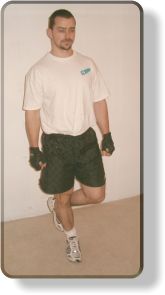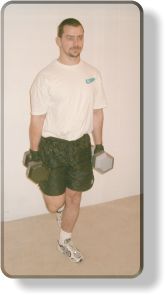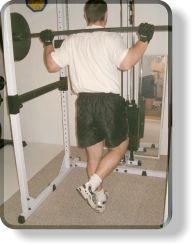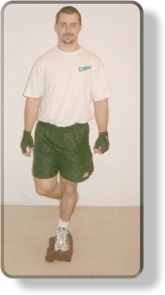Which often-neglected bodypart could you work that would have the greatest immediate impact on your sports performance? The ankles.
The ankles are admittedly not glamorous. You're never going to have someone ask you to flex your ankle for them or ask you to roll down your sock for a better look.
However, can you think of a single sport that doesn't involve the ankle in some way?
If you're playing football and you need to make a sharp lateral cut to avoid getting hit, the majority of that force goes right through the ankle. A weak ankle will turn and possibly sprain. A strong ankle will take that force and allow you to make that sharp, powerful cut and leave tacklers in the dust!
Think of every racket sport you can...how many of these involve planting a foot, lunging for ball then rapidly changing direction?
Even if you're just running or sprinting in a straight line, you can benefit from stronger ankles. When your foot contacts the ground, all the force of your muscles propelling you forward goes directly through the ankles.
And one more HUGE benefit to strong ankles?
With proper training, you can make them practically injury-proof. Using myself as an example, after doing ankle stability training (like the kind I'm about to tell you about), I had an instance playing tennis where I was lunging to the side to reach for a ball. My foot stopped but my momentum continued to carry my body laterally. My ankle bent 90 degrees, touching my outside ankle bone to the ground.
Without ankle strengthening, it would have been sprained for sure. As it was, my ankle popped right back up and I kept playing like nothing had even happened. No injury, no swelling, no tenderness, no problem.
Balance is another tremendous benefit. When your ankles are strong, you will be much better able to keep your balance even under awkward conditions.
Think about it...the small muscles of the ankle are constantly firing to maintain balance (if you've ever run in the sand, you know how sore your ankle and calf muscles get the next day). These small muscles play an extremely important role in balance. Strengthening them will give you a greater ability to maintain your balance, even if you've already got great balance right now.
So now that you know what ankle strengthening can do for you, let's get into the nuts and bolts of how to do it.
These exercises can be done at the end of your weight or cardio workout or at the end of sports practice sessions. I wouldn't recommend starting a training session (or especially a sports practice session) with them as fatiguing these support muscles and the connective tissue in the area will leave the ankles temporarily weaker and possibly more prone to injury (until they have a chance to recover and strengthen).
Doing these exercises at the end of a session avoids this potential issue completely.
You'll note that many of the concepts I will describe here involve balance training but with added twists to target them directly to ankle strengthening.
Here are the techniques:
1. Standing and balancing
This is a very simple exercise and the one we'll start with. All you need to do is stand on one foot and balance there for as long as you can.

As you work to keep yourself balanced, you will notice that your ankle is constantly shifting around to compensate for slight changes in your body position. This constant shifting is working the supporting muscles of the ankles.
You can do this exercise anywhere at any time. All you need to do is stand on one foot and balance there for a minute or two, then switch to the other foot. It's so easy, you can get it done at the bus stop or while you're making dinner.
It is deceptively simple but very effective. This is because in everyday life, you very rarely stand on one foot for any length of time. Your ankles and calves are not required to balance or support you as much. When you stand on one foot, you force these supporting muscle to work overtime.
For an added twist, try closing your eyes while balancing. Without the visual cues to help keep you balanced, your ankles will have to work much harder.
2. Standing and balancing with weights
The next step up from the previous exercise is holding onto a pair of dumbbells (or other form of resistance) while you are balancing on one foot. What this does is simply increase the resistance with which you are working. This increase in resistance will increase the demand on the muscles.

The more weight you use on this exercise, the more strength you'll be able to build up in your ankles. Think of it this way...if you're holding onto two 50-lb dumbbells, that's an extra 100 lbs that your body must work to balance. If you hold two 100-lb dumbbells, you've got 200 extra pounds. This is extreme overload and overload builds strength, especially when your ankle muscles have never experienced this kind of stress before.
If you get to the point where you're unable to hold onto the heavy dumbbells for long enough to be effective, you may wish to try placing a barbell across your shoulders as though you were doing a squat (do this in the squat rack with the safety rails set high). This will also have the effect of increasing the instability of the exercise, making it more challenging for the ankles.

Also, you'll be able to use FAR more weight (I've gone as high as 405 lbs for this version).
3. Standing on an unstable surface and balancing
Now that you've learned how to work with the dumbbells, it's time to move on to balancing on an unstable surface. This will really challenge the strength of your ankles.
Some good surfaces you can use include foam (like the foam on a flat bench), a pile of towels or clothing, sand, air mattress, etc. There are a great many surfaces that are effective for this. Feel free to use your imagination.
I like to use a folded-up towel set on the floor for this one - no need to buy any expensive equipment.

This balancing can be done either with or without weights. If you are using weights, I would suggest sticking to dumbbells - they're easier to control than the barbell.
Learn how to perform Full-Range Calf Raises here.
![]()
More From Fitstep.com
Share This Page...
---
Home -> Exercise Library -> Calf Exercises -> Ankle Stability

